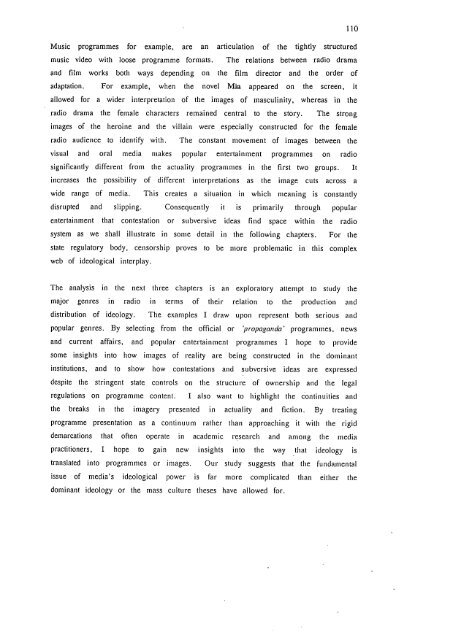iieiiei1eWrkers - Leicester Research Archive - University of Leicester
iieiiei1eWrkers - Leicester Research Archive - University of Leicester
iieiiei1eWrkers - Leicester Research Archive - University of Leicester
Create successful ePaper yourself
Turn your PDF publications into a flip-book with our unique Google optimized e-Paper software.
Music programmes for example, are an articulation <strong>of</strong> the tightly structured<br />
music video with loose programme formats. The relations between radio drama<br />
and film works both ways depending on the film director and the order <strong>of</strong><br />
adaptation. For example, when the novel Mia appeared on the screen, it<br />
allowed for a wider interpretation <strong>of</strong> the images <strong>of</strong> masculinity, whereas in the<br />
radio drama the female characters remained central to the story. The strong<br />
images <strong>of</strong> the heroine and the villain were especially constructed for the female<br />
radio audience to identil' with. The constant movement <strong>of</strong> images between the<br />
visual and oral media makes popular entertainment programmes on radio<br />
significantly different from the actuality programmes in the first two groups. It<br />
increases the possibility <strong>of</strong> different interpretations as the image cuts across a<br />
wide range <strong>of</strong> media. This creates a situation in which meaning is constantly<br />
disrupted and slipping. Consequently it is primarily through popular<br />
entertainment that contestation or subversive ideas find space within the radio<br />
system as we shall illustrate in some detail in the following chapters. For the<br />
state regulatory body, censorship proves to be more problematic in this complex<br />
web <strong>of</strong> ideological interplay.<br />
The analysis in the next three chapters is an exploratory attempt to study the<br />
major genres in radio in ternis <strong>of</strong> their relation to the production and<br />
distribution <strong>of</strong> ideology. The examples I draw upon represent both serious and<br />
popular genres. By selecting from the <strong>of</strong>ficial or 'propaganda' programmes, news<br />
and current affairs, and popular entertainment programmes I hope to provide<br />
some insights into how images <strong>of</strong> reality are being constructed in the dominant<br />
institutions, and to show how contestations and subversive ideas are expressed<br />
despite the stringent state controls on the structure <strong>of</strong> ownership and the legal<br />
regulations on programme content. I also want to highlight the continuities and<br />
the breaks in the imagery presented in actuality and fiction. By treating<br />
programme presentation as a continuum rather than approaching it with the rigid<br />
demarcations that <strong>of</strong>ten operate in academic research and among the media<br />
practitioners, I hope to gain new insights into the way that ideology is<br />
translated into programmes or images. Our study suggests that the fundamental<br />
issue <strong>of</strong> media's ideological power is far more complicated than either the<br />
dominant ideology or the mass culture theses have allowed for.<br />
110














